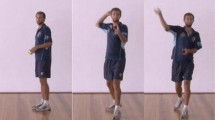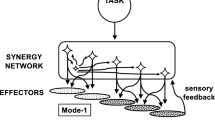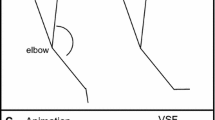Abstract
We studied the development of information–movement couplings in a ball-bouncing task with a special interest in how space- and time-related information is used by people of different ages. Participants from four age groups (children aged 7–8, 9–10 and 11–12 years, and adults) performed a virtual ball-bouncing task in which space- and time-related information were independently manipulated. Task performance and information–movement couplings were analyzed. Our results confirm a clear use of time-related information in adults, while children demonstrated a predominant relationship between space-related information and the period of movement. In the course of development, however, the children become progressively more capable of using time-related information in order to control the rhythmic ball-bouncing task. A second and weaker coupling, between ball height information and racket velocity at impact, also appears in the course of development. The data seem to show that the development of children follows the freezing–freeing–exploiting sequence proposed by Savelsbergh and Van der Kamp (Int J Sport Psychol 31:467–484, 2000), with a significant change in how information is used to control movement related to age.






Similar content being viewed by others
References
Ankarali MM, Tutkun Sen H, De A et al (2014) Haptic feedback enhances rhythmic motor control by reducing variability, not improving convergence rate. J Neurophysiol 111:1286–1299. doi:10.1152/jn.00140.2013
Bazile C, Siegler IA, Benguigui N (2013) Major changes in a rhythmic ball-bouncing task occur at age 7 years. PLoS One 8:e74127
Benguigui N, Baurès R, Le Runigo C (2008a) Visuomotor delay in interceptive actions. Behav Brain Sci 31:200–201
Benguigui N, Broderick MP, Baures R, Amorim MA (2008b) Motion prediction and the velocity effect in children. Br J Dev Psychol 26:389–407
Bernstein NA (1967) The co-ordination and regulation of movements. Pergamon Press, Oxford
Chihak BJ, Grechkin TY, Kearney JK et al (2014) How children and adults learn to intercept moving gaps. J Exp Child Psychol 122:134–152. doi:10.1016/j.jecp.2013.12.006
Cohen J (1988) Statistical power analysis for the behavioral sciences, 2nd edn. Lawrence Erlbaum Associates, Hillsdale
Davids K, Kingsbury D, Bennett S, Handford C (2001) Information–movement coupling: implications for the organization of research and practice during acquisition of self-paced extrinsic timing skills. J Sports Sci 19:117–127. doi:10.1080/026404101300036316
Deutsch KM, Newell KM (2005) Noise, variability, and the development of children’s perceptual-motor skills. Dev Rev 25:155–180. doi:10.1016/j.dr.2004.09.001
Drake C, Jones MR, Baruch C (2000) The development of rhythmic attending in auditory sequences: attunement, referent period, focal attending. Cognition 77:251–288
Droit-Volet S, Zélanti P (2013) Development of time sensitivity: duration ratios in time bisection. Q J Exp Psychol 66:671–686. doi:10.1080/17470218.2012.712148
Edwards WH (2010) Motor learning and control: from theory to practice. Wadsworth Cengage Learning, Belmont
Gibson EJ (1988) Exploratory behavior in the development of perceiving, acting, and the acquiring of knowledge. Annu Rev Psychol 39:1–42
Hay L, Bard C, Fleury M, Teasdale N (1991) Kinematics of aiming in direction and amplitude: a developmental study. Acta Psychol (Amst) 77:203–215
Herzfeld DJ, Shadmehr R (2014) Motor variability is not noise, but grist for the learning mill. Nat Neurosci 17(2):149–150. doi:10.1038/nn.3633
Houdé O, Borst G (2014) Measuring inhibitory control in children and adults: brain imaging and mental chronometry. Front Psychol 5:616. doi:10.3389/fpsyg.2014.00616
Lantero DA, Ringenbach SD (2007) Developmental differences in the use of visual information during a continuous bimanual coordination task. J Mot Behav 39:139–155
Le Runigo C, Benguigui N, Bardy BG (2010) Visuo-motor delay, information–movement coupling, and expertise in ball sports. J Sports Sci 28:327–337. doi:10.1080/02640410903502782
Lee DN, Craig CM, Grealy MA (1999) Sensory and intrinsic coordination of movement. Proc Biol Sci 266:2029–2035
Manyam VJ (1986) A psychophysical measure of visual and kinaesthetic spatial discriminative abilities of adults and children. Perception 15:313–324
Morice AHP, Siegler IA, Bardy BG, Warren WH (2007) Learning new perception–action solutions in virtual ball bouncing. Exp Brain Res 181:249–265
Morice AHP, Siegler IA, Bardy BG (2008) Action-perception patterns in virtual ball bouncing: combating system latency and tracking functional validity. J Neurosci Methods 169:255–266
Newell KM (1986) Constraints on the development of coordination. In: Wade MG, Whiting HTA (eds) Motor development in children: aspects of coordination and control. Nijhof, Dordrecht, pp 341–360
Redon C, Hay L, Rigal R, Roll JP (1994) Contribution of the propriomuscular channel to movement coding in children: a study involving the use of vibration-induced kinaesthetic illusion. Hum Mov Sci 13:95–108
Savelsbergh GJ, van der Kamp J (2000) Information in learning to co-ordinate and control movements: is there a need for specificity of practice? Int J Sport Psychol 31:467–484
Siegler IA, Bardy BG, Warren WH (2010) Passive vs. active control of rhythmic ball bouncing: the role of visual information. J Exp Psychol Hum Percept Perform 36:729–750
Siegler IA, Bazile C, Warren WH (2013) Mixed control for perception and action: timing and error correction in rhythmic ball-bouncing. Exp Brain Res 226:603–615
Sternad D, Duarte M, Katsumata H, Schaal S (2001) Bouncing a ball: tuning into dynamic stability. J Exp Psychol Hum Percept Perform 27:1163–1184
Thelen E, Smith LB (1994) A dynamic systems approach to the development of cognition and action. The MIT Press, Cambridge
Van der Kamp J, Oudejans R, Savelsbergh GJ (2003) The development and learning of the visual control of movement: an ecological perspective. Infant Behav Dev 26:515
Vereijken B (2010) The complexity of childhood development: variability in perspective. Phys Ther 90:1850–1859. doi:10.2522/ptj.20100019
Vereijken B, Whiting HTA, Newell KM, Van Emmerik REA (1992) Free(z)ing degrees of freedom in skill acquisition. J Mot Behav 24:133–142
Volman MJ, Geuze RH (2000) Temporal stability of rhythmic tapping “on” and “off the beat”: a developmental study. Psychol Res 63:62–69
Warren WH (2006) The dynamics of perception and action. Psychol Rev 113:358–389
Wu HG, Miyamoto YR, Gonzalez Castro LN et al (2014) Temporal structure of motor variability is dynamically regulated and predicts motor learning ability. Nat Neurosci 17:312–321. doi:10.1038/nn.3616
Author information
Authors and Affiliations
Corresponding author
Rights and permissions
About this article
Cite this article
Bazile, C., Benguigui, N. & Siegler, I.A. Development of information–movement couplings in a rhythmical ball-bouncing task: from space- to time-related information. Exp Brain Res 234, 173–183 (2016). https://doi.org/10.1007/s00221-015-4443-1
Received:
Accepted:
Published:
Issue Date:
DOI: https://doi.org/10.1007/s00221-015-4443-1




